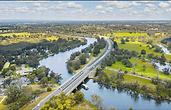What will Perth look like in 30 years?
If your daily commute currently includes a long slow trip on the Mitchell or Kwinana freeways to the CBD, it’s frightening to think of the impact an extra 2.3 million people would have on that journey. This however is the challenge facing those planning the future of Perth, with demographers predicting that Perth’s population of 2 million is projected to reach 4.3 million by 2046.
A report by Infrastructure Australia states that in the coming 30 years, Perth, along with Brisbane, will experience fundamental change, with each growing to the size of Melbourne and Sydney today. Perth will surpass Brisbane as Australia’s third largest city.
While this will create exciting opportunities for Perth and other cities around the country, it will present everyday Western Australians, politicians and planners with some complex and hard choices. The Infrastructure Australia report outlines a number of changes that will need to be considered to ensure Perth can cope with this increased population, with a focus on the city growing up instead of further out and with evolving technology locating employment closer to where people live. Infrastructure Australia CEO Philip Davies explained the findings of the research and the challenges ahead during a recent speech to launch the report.
“Do we want to continue to live on a quarter acre block and commute hours to work?” he asked. “Or should we embrace high quality high density living close to public transport and world-class amenities, or locate our employment centres closer to where people live?” Mr Davies believes the type of city we choose to live in today will have a dramatic impact on our journey to work, congestion on our roads, cost of housing and access to public transport, schools, hospitals and our public parks in the future.
In recent years, there has been a dramatic increase in the amount of public transport. Here in Perth we are already seeing that trend with the pending construction of the Government’s main election promise – Metronet. The challenge will be to get people out of their cars and onto a train or bus. And even on the roads, the rise of new technology like driverless cars will also change the face of our city. Experts point out that driverless cars will mean the ability to pack more cars into the same area of road. That’s simply because these cars will have technology that will actually make tail-gating the way we drive with high tech capability to synchronise traffic to the point where back end crashes could virtually be eliminated. One of the biggest repercussions of this population growth for Perth, apart from transport, is the impact on housing.
According to Australia’s small area population forecasters .id, areas on the edge of the metropolitan region will have a population boom by 2036 as more and more councils re-zone land to allow owners to sub-divide.
We are already seeing in Perth the move towards packing more homes into smaller spaces. You can see this as you drive around many of Perth’s outer suburbs, with block sizes halved compared to even 10 years ago.
Closer to the city we see a relatively new phenomena in Perth, more and more apartment living. We’re also seeing more older homes being knocked down and the block subdivided so that two homes or even three or four can be built.
Forecasters predict that a staggering 400,000 people could be living in Wanneroo by 2041 and growth in Serpentine-Jarrahdale is expected to jump more than 120 percent, escalating from 31,000 people in 2018 to 68,000 by 2036.
As evidenced by the recently announced development plans for apartment living around Belmont Racecourse and the new Optus Stadium, Perth will likely continue to see more and more apartment complexes being built, and the size of blocks in new suburbs shrinking from the old quarter acre block of the 60s down to as little as 300sqm or below. And finally even the way we do our jobs will change. More and more employees are likely to be encouraged to use technology to work from home. We see this already but it just makes sense to employees and employers that, rather than spending two hours a day stuck in traffic, we will be able to achieve the same job without necessarily being in the same place. Oh yes – and one more thing. These are predictions based on what we know. Even five years ago who would have even imagined a world with Uber? Now we’re heading for a time when your Friday night pizza will come via a drone. And, to a large extent, there will be plenty of things that haven’t even been invented yet that will make living in a city like Perth look very different to what we see and experience today.
Todays Good Reads
Does the internet have a problem with Amber Heard?
Its everyone’s favourite show trial, but does the internet hate Amber Heard?
Spores that can mess up your day.
Mould can cause serious health issues. Here is how best to deal with its effects.
Singlets in winter.
This years AFL season is WILD. Here is a condensed version of what is happening off the field this week.

La Niña: El Niño’s less famous sibling.
On a day where Perth is getting hammered by heavy downpour, why don’t we take a second to understand how rainfall patterns and weather patterns as a whole are changing over time, and what we can learn from it.
La Niña occurs when equatorial trade winds become stronger, changing ocean surface currents and drawing cooler deep water up from below. This results in a cooling of the central and eastern tropical Pacific Ocean. The enhanced trade winds also help to pile up warm surface waters in the western Pacific and to the north of Australia.
The warming of ocean temperatures in the western Pacific means the area becomes more favourable for rising air, cloud development and rainfall. As a result, heavy rainfall can occur to the north of Australia. Conversely, over the eastern and central tropical Pacific, air descends over the cooler waters, meaning the region is less favourable for cloud and rain. The air rising in the west and descending in the east enhances an atmospheric circulation – called the Walker circulation – which can result in changes to the climate felt across the globe.
Monitoring La Niña
The term La Niña describes a particular phase of the ENSO climate cycle. ENSO is a coupled atmosphere-ocean phenomenon, which means that the transition between La Niña, El Niño and neutral conditions (neither El Niño nor La Niña) is governed by interactions between the atmosphere and ocean circulation.
In the atmosphere, ENSO is monitored via the Southern Oscillation Index (SOI), a measure of atmospheric circulation that takes the difference of atmospheric pressure between Darwin and Tahiti. In the ocean, ENSO is most commonly monitored through observed sea surface temperatures within a region of the central and eastern tropical Pacific known as NINO3.4.
El Niño and La Niña are not turned on and off like a switch. Rather, El Niño and La Niña are a function of the strength of departures from average in NINO3.4 and the SOI. This means that if conditions are close to La Niña (El Niño) thresholds, one might expect to see some La Niña-like (El Niño-like) effects on Australia.
La Niña events are typically defined when SOI values are sustained above +7 and NINO3.4 temperatures are more than −0.8 °C below average. Events that maintain index values close to these thresholds are generally classified as moderate to weak, while those that greatly exceed them are referred to as strong.
Increased rainfall
The increased rainfall and cloudiness in the western Pacific associated with La Niña usually means above-average winter–spring rainfall for Australia, particularly across the east and north.
The six wettest winter–spring periods on record for eastern Australia occurred during La Niña years. In the Murray–Darling Basin, winter–spring rainfall averaged over all 18 La Niña events (including multi-year events) since 1900 was 22% higher than the long-term average, with the severe floods of 1955, 1988, 1998 and 2010 all associated with La Niña.
Cooler temperatures
La Niña years tend to see cooler than average maximum temperatures across most of mainland Australia south of the tropics, particularly during the second half of the year. This is due to increased cloud cover and rainfall. However, the increased cloud cover tends to act as an insulator and results in warmer than average minimum temperatures across northern and eastern Australia during La Niña.
Australian winter–spring mean maximum temperature deciles averaged for twelve strong La Niña events.
Shift in temperature extremes
The cooler than average daytime temperatures during La Niña years is often associated with a decreased frequency of extreme daily high temperatures.
In the warmer half of the year, southern coastal locations such as Adelaide and Melbourne experience fewer individual daily heat extremes during La Niña years but an increased frequency of prolonged warm spells. Of the 32 Victorian heatwaves between 1989 and 2009, 17 occurred during La Niña years while only 6 occurred during El Niño 3.
Due to increased cloud cover and hence warmer nights, regions of southern New South Wales and northern Victoria can experience less frost days during La Niña than the historical average 4.
Increased tropical cyclone numbers
During La Niña, there are typically more tropical cyclones in the Australia region, with twice as many making landfall than during El Niño years on average 5. The first cyclone to cross the Australian coast also tends to occur earlier in the season. The only years with multiple severe tropical cyclone landfalls in Queensland have been La Niña years 6. This means an increased likelihood of major damage and flooding related to strong winds, high seas and heavy rains from tropical cyclones.
Earlier monsoon onset
The date of the monsoon onset in tropical Australia is generally two weeks earlier during La Niña years than in El Niño years 7. This means that rainfall in the northern tropics is typically above-average during the early part of the wet season for La Niña years but only slightly above average during the latter part of the wet sea
Content with more content
Now if you prefer to consume your information through audio instead of through text (which is understandable) come and check out or podcast which lives here. It is a show we are doing weekly which has a nice blend of education and entertainment aimed at the prospective homebuyer.





